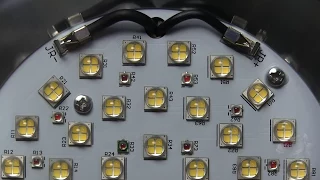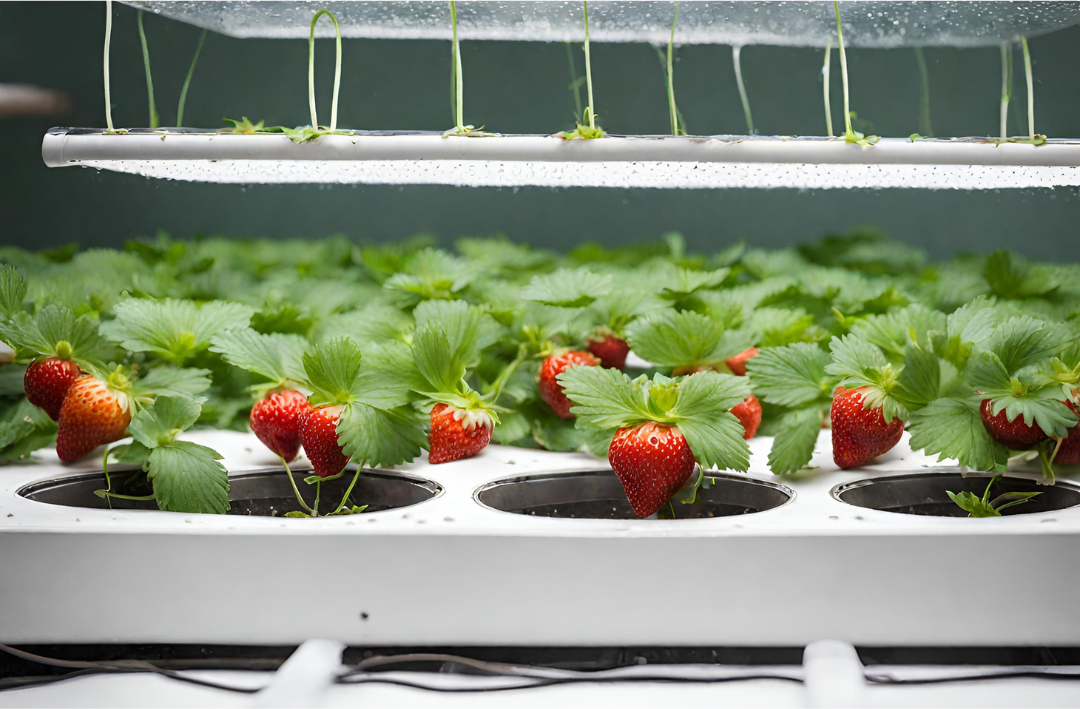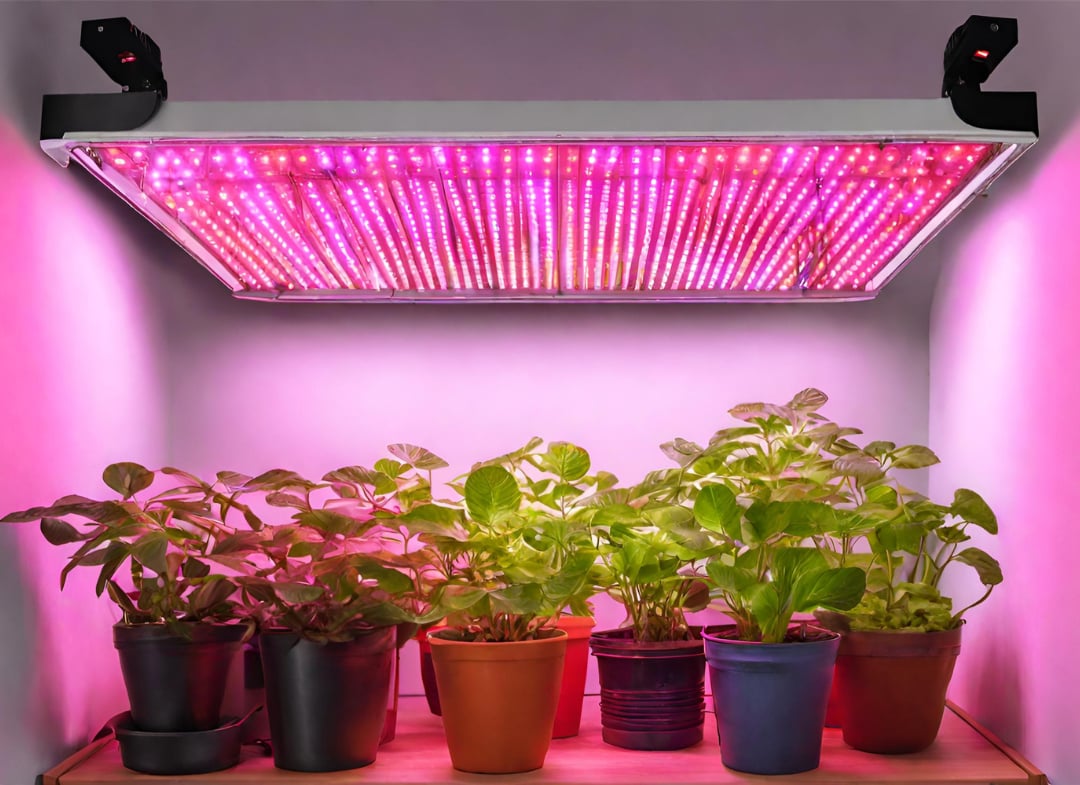
TESTLAB: How LEDs Work & The Spectrum King Test

Transcript
Hello, Monster Gardeners and welcome back to the Test Lab. My name is Dr. Watt and today I’m afraid I’m the bearer of more bad news. Sadly, the Spectrum King test is no more.
You know I’m just kidding, right? Today is the culmination of a journey that started over a year ago when I first reached out to LED manufacturers to try and create the biggest LED comparison video ever. But we all know what happened there. If you don’t, then you might want to go and skip back the first episode of Season 2 to get the full story. But for those of you who’re still here, let’s take our first dive into the odd world of light-emitting diode. Because to understand LEDs, you have to forget everything you know about traditional gas discharge technologies. Because LEDs work completely differently.
Gas discharge lighting uses a mixture of solids and gases excited by an electrical charge in order to produce light. For decades they’ve been the kings of efficiency and output, but their dominance in recent times has been threatened by a technology that has its roots in the world I used to live in: microelectronics.
Contrary to what the average person thinks, the light-emitting diode is not a new technology and traces its roots back to 1907 when a very clever chap called Captain Henry Joseph Round, a Brit like me working in America, noticed for the first time that if a charge of just 10 volts was applied to silicon carbide crystal it emitted yellowish light.
For decades tiny steps forward were made by people you’ve probably never heard of, like Gary Pittman and Bob Biard, Nick Holonyak, M. George Craford, and Shuji Nakamura. All of these scientists contributed massively to the technology you’re most likely looking at right now. Screens at one of the wide array of applications for LEDs, and their close cousins organic LEDs, but what the hell is an LED and how does it make light?
All LEDs are made from special materials called semiconductors that have an electrical conductivity value falling somewhere between conducting materials such as copper and non-conducting materials such as glass. What makes them special is that we can alter their conductive properties in lots of interesting ways using a process called doping.
In their simplest form, all LEDs are what are known as P-N Junctions in a microelectronics world. P-N Junctions are simply interfaces or boundaries between positive and negative semiconductor materials. Doping is the process of adding impurities to intrinsic semiconductor materials such as silicon in order to change their electrical characteristics.
In the case of P-N Junction, it means messing about with the amounts of electrons present in the material itself. Now, if you stretch your memory back to high school science, you’ll know that what we commonly refer to as “electricity” is, in fact, the flow of electrons that are carrying a charge. So, by controlling the flow we can control the charge and make it do what we want to. By using the process of doping we can add extra free electrons where we want them, creating a negatively charged or n-type region of semiconductor, or we can add electron holes, creating the positively charged or p-type region of the semiconductor. These holes and electrons are attracted towards each other just like the north and south poles of a magnet. Here [refering to the image on screen] you can see a basic P-N Junction model. The P-side has been doped to have an excess of electron holes and the N-side has been doped to have an excess of electrons. Where the two meet is the P-N Junction itself and this is where it gets interesting.
The electron holes in the P-type and the electrons in the N-type are attracted to each other, and at the junction interface itself they begin to recombine, with electrons filling holes, but this only occurs in the first few layers. This is because, when they recombine, the process of recombination creates an electrical field that repels all the other holes and electrons. This field is called the depletion zone. With the P-N Junction in this state, it reaches a balanced equilibrium we like to call zero bias. However, if we add enough current to overcome the electrical field the electrons begin to recombine again, and in an LED, it’s in this recombination process that produces the light that we see, which is actually a by-product.
This is, of course, a massive oversimplification of what happens in an LED, but for our purposes, it explains just enough for you to understand the basic principles at work. With LEDs having such a long history why has it taken so long for them to get into grow lighting? Simply put, this is because making LEDs is far more complicated than making gas discharge bulbs and they’ve only really been bright enough to use for major indoor lighting applications since about the mid-1990s. However, in the same way that all electronics have experienced exponential gains in speed and power, whilst also shrinking in size, LEDs are on exactly the same trajectory. What this basically means is that barring some other technical breakthroughs that are unknown and on the horizon, LEDs will be in your future at some point soon. It’s almost inevitable.
In the same way that everything from computers to cellphones have become more powerful and cheaper to produce every generation, LED grow lights will also become increasingly powerful, more efficient, and cheaper to produce. So, eventually, everything might become LED. However, that’s clearly not happened quite yet. At some point over the next 10 to 20 years LEDs will become a “no brainer” choice, as DE-HPS is now, but currently, they’re still far more expensive when compared to their equivalent gas discharge technology brethren. So why are so many people switching?
Well, in Season 1 we touched on concepts like costs of ownership, and also shifting your thinking away from just looking at the upfront cost and towards looking at where your money goes. With all artificial lighting, the purchase price actually equates to a rather small amount of total cost in comparison to the amount of electricity it will use to run that lamp for several harvests. And that’s not including things like bulbs or reflectors, both of which need regular replacement for optimum efficiency and output. So, the amount you pay for the fixture should not be the only consideration when choosing your lighting.
To add to these complexities, you also have to take into consideration factors such as design philosophy, due to the vast array of different types of LED fixtures that exist, and again, the spectrum. I can’t underline this enough. Presently, the vast majority of LED fixtures fall into either the full spectrum type, such as the Spectrum Kings, or the red-blue type, which often also feature tunable frequencies to create light recipes of mythical status. So hold tight, because from here on out, things are going to move fast.
From the little closet helper to the full-fat SK600, I’ve seen enough lighting to know good engineering now, and these fixtures are very well engineered, and that’s just looking at the shell. If we focus on the circuit boards that carry the diodes themselves, these are like works of art in my eyes. Everywhere you look there are interesting details, which brings me very neatly to the enormous heat sinks you can see. LEDs, like all lighting technologies, generate a lot of heat. This is a byproduct of generating photons, and it’s really the downside of LEDs. The best and most efficient LEDs are actually very small, but per square inch generate much more heat than their size suggests, and that’s heat that has to be dispersed.
In the vast majority of LED fixtures, there are two ways of dealing with this excess heat: fans or heat sinks. Fans obviously work by blowing cool air on top components but do have a tendency to fail, which is their Achilles heel. Heat sinks, on the other hand, have no moving parts and rely on thermal transfer instead. Heat from the diodes is transferred into an array of fins that have a large surface area and simply allow the heat to naturally escape into the atmosphere. All of this, and it only weighs around 20 pounds. Like I said, I’m a sucker for good engineering. But enough of the love, for now, let’s have a look at the numbers.
THE TEST
For LEDs, we’ve developed a new version of our 5x5 canopy test. We’ll be gathering all the usual data that we’ve collected in previous seasons, but because of the new tent setup being so much quicker than the old one, we can now test at several heights, or in this case, five. Yes, that’s right, for the full-size fixtures this means that 125 samples are taken over distances 24, 30, 36, 42, and 48 inches for each fixture. Now that’s a lot of numbers.
RESULTS
We have four of Spectrum King’s offerings, the 100-watt Closet Case, the SK400, the SK400 Plus, and the SK600. The Closet Case is a small, 100-watt fixture that is for exactly as it says it is, small footprint applications where you’d use something more along the lines of a T5 or something like a low-wattage HID. As it’s a small footprint fixture, testing it on our 5x5 grid would be a bit unfair, but luckily enough, I’ve already built a 4x4 grid overlay that better mimics a smaller footprint tent. I did this when I rebuilt the test lab, foreseeing the problem with close proximity fixtures. However, there’s been a lot of argument about the correct height to hang these fixtures at, so I devised a multi-level test that would help answer those questions. As it’s a 4x4 grid, we’ll be testing it at four different heights: 12, 18, 24, and 30 inches, on the new 4x4, 16-sport grid.
As we’ve developed these new 3D canopy tests, with far more data on them, it’s been a challenge showing all on the screen at the same time. So, we’ve had to get a bit funky in order to show it all on the screen and make it reasonably legible. Here’s a quick rundown of our new data graphic. On the left-hand side, you can see all the data related to the fixture and the conditions present during a test. And on the right, we have the four levels of the test taken at 12, 18, 24, and 30 inches, plus of course, all the actual numbers for each level, the canopy average, uniformity ratio, and the integration time the spectrometer used for the leveling question.
As the Closet Case fixture clearly shows, its design fits the purpose it’s built for perfectly. It’s ideal for a little 4x4 tent and you must remember that all our readings are taken from our non-reflective tent, meaning that all of the data is taken purely from the fixture itself without any reflectivity. This means that these edge readings won’t look anything like as wimpy in the real world, and as for height, somewhere between 18 to 24 inches seems optimum. But, of course, this does depend on where in your cycle you are. And checking with the Spectrum King’s web specs backs this up, with veg recommended at 18 to 24 inches and flowering recommended at 10 to 18 inches. It’s a wonderfully unique piece of kit, and two of the guys at Monster Gardens have already bought their own. However, this was just before we found out that there’s now a 140-watt version that’s just come out a few weeks ago.
SK400 and SK400 Plus Test
Moving on, we take a look now at the full-sized fixtures, beginning with the SK400 and the SK400 Plus. Why both together? Well, mainly because the SK400 is now discontinued. The reason we tested it at all is because the SK400 Plus is basically the same fixture as the SK400, but with slightly better components, giving it a 10% bump in power, whereas the SK400 has an enormous 90-degree reflector on board. The SK400 Plus has the 120-degree low-profile reflector, and I was curious as to just how big of a difference it would make. Both fixtures came with a massive truss bar I had to remove in order to hang it in the tent, giving some hint as to its potential application. Both certainly look like greenhouse fixtures and the IP-65 rating on all the Spectrum Kings means they can essentially be hosed down.
I’m going to start with the SK400 Plus because the reflector is one of the main talking points here. Configured as it is, with the low-profile 120-degree reflector, the canopy is extremely flat, perfect for large compounding light plans where light from multiple fixtures, correctly spaced, compounds together to intensify the complete lighting canopy. The side effect is it makes the higher elevation readings look a bit wimpy because there’s so much light spilling laterally, and without the reflective walls it just gets absorbed by our tent. So, you’d think that chopping off 10% of its power would make it worse, right? But wait! Remember that reflector? Take a look at that, numbers up across the board. It looks like it could handily compete with anything in the 600 to 750-watt range in HIDs. Like last season’s 600-watt test winner, the Single-Ended Hortilux Super HPS or perhaps even metal halide. Because it’s got a better spectrum than a metal halide. Having said that, it’s got a better spectrum than a ceramic metal halide, all of the Spectrum Kings do. I can’t underline how close the fixture’s light look to natural light when you look at it in person. Add the fact that even the SK400 Plus is pulling over 100-watts less than the 600-watt HID, that’s huge! That’s a sixth of your electrical bill saved every year, a sixth! So now you get a good idea of why I’ve been so excited since the season opener because the SK600 pulls a minimum of 600 watts.
SK600 Test
This fixture is just awesome. Obviously designed for indoor or covered applications, suggested by its side heat sinks, that allow it to have a much lower profile at the expense of the increased shadow. However, it’s still an IP-65 fixture, so you could practically water your entire indoor garden with a fire sprinkler system without too much worry. So, let’s take a look at some data. Holy sh*t, this thing delivers. At 36 inches it’s putting out numbers close to DE-HPS, but using almost a third less power, well over 30% less juice. And this is with its 120-degree reflector. There is even a 90-degree reflector available, which is one of the reasons for showing you the difference between the SK400 and the SK 400 Plus.
Okay, so let’s take a reality check. No, it’s not as powerful as the best DE-HPS greenhouse fixtures like the P.L. NXT 2 or a Gavita, but that’s because we tested them at 36 inches, which is already questionably low for an HID fixture. It’s a fact necessitated by our blacked-out tent and it’s not the height recommended they be used at, however, as the SK600 runs a lot cooler than any HID I’ve ever come across. You could likely hang it much closer than you would an HID lamp, meaning that the 36-inch test we use for DE-HPS is more like a 30-inch test with the SK600. And when you look at it like that, things get really interesting. The downside of all of this excitement is, of course, the initial cost. 1,500 big ones is a lot of money in the face of it, but it’s an insignificant amount when compared to the drip, drip, drip of electrical cost. So, there you have it. The impending disruption of the lighting industry is nigh. A small U.S. company in San Diego has created the best grow light that I have ever tested. And really, LED, in developmental terms, is essentially a baby still learning to walk. So, stay tuned, this is only the beginning. Now, I just wanted one final word on the SK600. Firstly, I’m not kidding when I say it is the best grow light I’ve ever tested, in fact, there’s even a new model out now with 40 extra watts. But please remember, I do not grow, at all. I’m just good with designs and handy with a camera. The real test is out there in your gardens across the world, and gardeners should all be on notice that LED has finally come of age. It’s time to take it seriously.
That’s it for this episode. After a complete rebuild and more problems than Jay-Z ever had, I hope it was worth the wait, and thanks again to Brendan Strath and all the crew at Spectrum King. I will await updates with Jedi-like focus. It’s time to wrap up, but before I go don’t forget to like or follow us across the social web-sphere and to subscribe to ensure you get every episode of the show. But for now, my name’s Dr. Watt and I’ll see you on the next episode of the Test Lab.
About the Author












